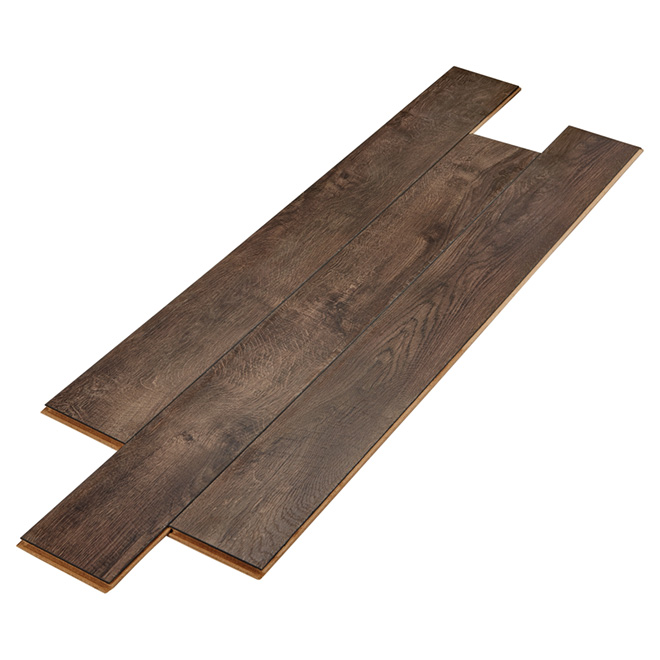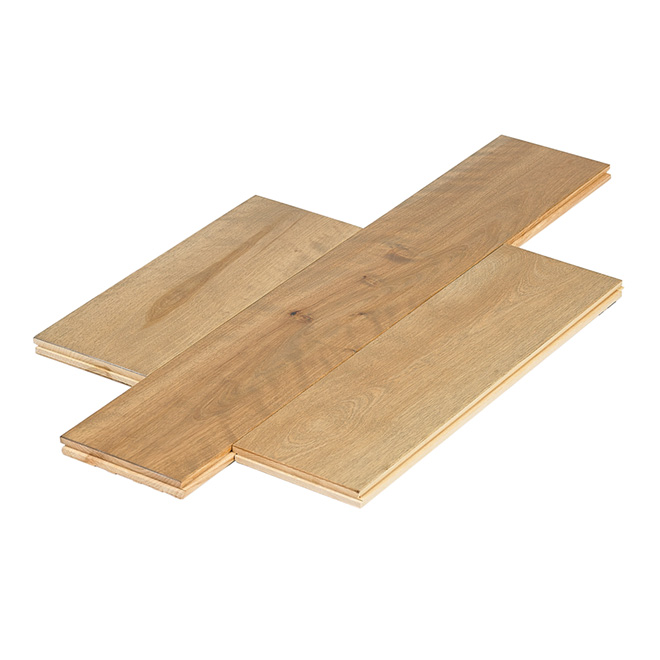The Different Types of Flooring for Kitchens
Ceramic tiles
Ceramic tile is often the kitchen flooring go-to. Its advantages paired with limitless options—size, color, shape, pattern and even texture—makes it a great choice for any style.
Advantages:
- Durability and longevity coupled with a slim price tag make this material a homeowner favorite. Spills, foot traffic, pets and more couldn’t destroy these floors if they tried.
- Clean-up is simple—mop, vacuum or sweep as the situation calls for it.
- What’s more? Tile size is often sold in 12² x 12² squares, making it easy to transport and install
Disadvantages:
- In older homes, the grout lines and even the tiles themselves can crack if the subfloors settle.
- Tile is not forgiving in the slightest—if you drop a dish, it’s a goner.
- Standing on the hard surface for long periods of time may become uncomfortable, and if you’re in bare feet it will be cold.
- Liquids will make the floor ultra-slippery.
Grout lines are often difficult to keep clean, but periodic deep cleaning and sealing will help.

Vinyl Flooring
Vinyl is no longer the cheap, tacky flooring material it used to be. Chic finishes and designs are now available with the option of using wide sheets or individual tiles. Vinyl often imitates other materials—tile, stone, wood—quite well, actually.
Advantages:
- Price is its main advantage. Get the similar look of other materials at a significantly reduced price.
- Installation is easy, this is a project you could tackle (saving money yet again!).
- Clean up is quick and simple, but keep in mind that textured vinyl will harbor some dirt.
- Unlike the other dense flooring materials, vinyl is actually quite comfortable to stand on.
Disadvantages:
- Though the price is right, the durability is not. Expect your floors to wear away after only five years.
- Dirt and other contaminants can make tiny scratches in the surfaces, dulling its finish over time.
Vinyl does tear, so if you drop a knife you’ll likely do some damage. It can also fade in the sunlight and even curl, dent and bubble as it ages. Overall, durability is not its strong suit.

Laminated flooring
Laminated flooring is made of layers of engineered material glued together. The top layer is often a thin veneer of wood. Veneers are available in different thicknesses, allowing you to refinish the surface. The thicker the veneer, the costlier the material.
Advantages:
- Sometimes closely resembles the look of real wood or tile without the hefty price tag.
- Installing is easy, so you’ll not only save on the cost of material, but also on the installation. In fact, many homeowners simply DIY.
- Maintenance and clean-up is a breeze—sweep and/or mop.
- Laminate doesn’t scuff or scratch making it a great addition to kitchens with extreme use or destructive children and pets.
Disadvantages:
- Though the look closely resembles the real-deal, the overall feel of the floors will not. Some say these floors feel hollow, and noise levels on them are often high.
- If you’ve chosen a thin veneer on top, you likely won’t have enough wood to sand down and refinish—sadly, when the floors show signs of wear and tear, they will need to be completely replaced.
Stone Flooring
Natural stones have been used as flooring for centuries, especially in the kitchen. Slate, marble, limestone and travertine are popular, but there are many options when it comes to stone. This material lends the kitchen an elegant foundation, and the rich variation from piece to piece—no two cuts of stone are identical—is a beautiful feature that other materials can’t imitate properly.
Advantages:
- Stunning floors that will last a lifetime, natural stone is a timeless, classic
- Cleanup is simple—much like that of ceramic tile but depending on the installation; you might not have the grout lines to deal with.
- Colors, styles and installation patterns are extremely diverse: you’re sure to find a stone to coordinate with the style of your kitchen.
Disadvantages:
- Though the beauty is extraordinary, so is the price tag.
- Textured surfaces become a little more difficult to keep clean as food and grime can get stuck in the crevices.
- Rock hard, literally, you won’t want to stand long on natural stone without a rug or mat; and, like ceramic tile, if you drop a plate or cup, you might as well say good-bye.
- Installation is difficult and meticulous, not for the DIY-er.
- The layers in slate sometimes peel with age, soft stones can chip or scratch and porous stones will need to be protected with the occasional sealer.

Hardwood Floors
Wood is timeless and classic, never going out of style. When properly maintained, solid wood floors can last a lifetime—even in the kitchen. The heavy traffic will create a beautiful patina over time, but remember that the floors can always be sanded and refinished again to look like new.
Advantages:
- Wood caters to many styles with the diverse species available for flooring as well as installation patterns. From light maple to exotic ipe and skinny planks to intricate designs, there is a wide variety of choices and patterns for every taste.
- Wood floors bring a sense of warmth and charm to a space while feeling lovely underfoot.
- Solid wood floors are a classic that won’t soon need replacing.
Disadvantages:
- Moisture, from leaks behind the refrigerator to spills on the floor, can do serious damage if not quickly taken care of.
- Some wood species dent or scratch easily, needing refinishing.
Wood floors fall somewhere between cork and concrete on the shock-absorbing scale—different woods have different densities.
Concrete Flooring
With the explosion of the industrial-chic style came the transformation of concrete floors. What used to only be seen in the basement, garage and beneath other flooring materials suddenly found itself in the spotlight. Staining, texturing, stamping, acid etching, and more, turns the old grey cement we used to know into a stunning, durable flooring material.
Advantages:
- It doesn’t get much more durable than solid concrete which is basically indestructible.
- Clean up is a breeze.
- Styles are unlimited, and can even mimic other materials through the use of faux finishes.
- Also, concrete is the perfect subfloor, so if you ever want to install tile, carpet or wood overtop, you’re ready to go!
Disadvantages:
- Concrete is downright cold come wintertime.
- It is hard and unforgiving, both on your feet and dropped dishware.
- If the concrete isn’t already in place, chances are you’ll need professional installation.
Because concrete is a porous material, you’ll need to seal it to keep stains at bay.















